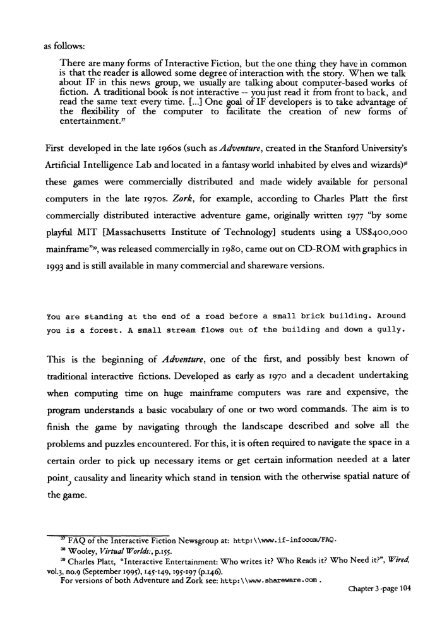From Page to Screen - WRAP: Warwick Research Archive Portal ...
From Page to Screen - WRAP: Warwick Research Archive Portal ...
From Page to Screen - WRAP: Warwick Research Archive Portal ...
You also want an ePaper? Increase the reach of your titles
YUMPU automatically turns print PDFs into web optimized ePapers that Google loves.
as follows:<br />
!here are many forms of Interactive Fiction, but the one thing they have in common<br />
1S that the reader is allowed some degree ofinteraction with the s<strong>to</strong>ry. When we talk<br />
about IF in this news group, we usually are talking about computer-based works of<br />
fiction. A traditional book is not interactive -- you just read it from front <strong>to</strong> back, and<br />
read the same text every time. {...] One goal ofIF developers is <strong>to</strong> take advantage of<br />
the flexibility of the computer <strong>to</strong> facilitate the creation of new forms of<br />
entertainment."<br />
First developed in the late 1960s (such as Adventure, created in the Stanford University's<br />
Artificial Intelligence Lab and located in a fantasy world inhabited by elves and wizards)"<br />
these games were commercially distributed and made widely available for personal<br />
computers in the late 1970s. Zork, for example, according <strong>to</strong> Charles Platt the first<br />
commercially distributed interactive adventure game, originally written 1977 "by some<br />
playful MIT {Massachusetts Institute of Technology] students using a US$400,000<br />
mainframe">, was released commercially in 1980, came out on CD-ROM withgraphics in<br />
1993 and is still available in many commercial and shareware versions.<br />
You are standing at the end of a road before a small brick building. Around<br />
you is a forest. A small stream flows out of the building and down a gully.<br />
This is the beginning of Adventure, one of the first, and possibly best known of<br />
traditional interactive fictions. Developed as early as 1970 and a decadent undertaking<br />
when computing time on huge mainframe computers was rare and expensive, the<br />
program understands a basic vocabulary of one or two word commands. The aim is <strong>to</strong><br />
finish the game by navigating through the landscape described and solve all the<br />
problems and puzzles encountered. For this, it is often required <strong>to</strong> navigate the space in a<br />
certain order <strong>to</strong> pick up necessary items or get certain information needed at a later<br />
point) causality and linearity which stand in tension with the otherwise spatial nature of<br />
the game.<br />
37 FAQ of the Interactive Fiction Newsgroup at: http:\\www.if-infocom/FAQ.<br />
38 Wooley, Virtual Worlds:, P.155.<br />
39 Charles Platt, "Interactive Entertainment: Who writes it? Who Reads it? Who Need it?", Wired,<br />
vol.j, nO.9 (September 1995), 145-149, 195-197(P.146).<br />
For versions of both Adventure and Zork see: http:\\www.shareware.com.<br />
Chapter 3 -page 104





